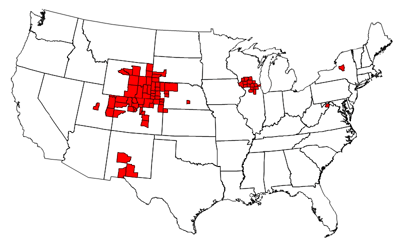About CWD
 |
|
| Captive elk (Courtesy: Ryan Maddox, CDC) | |
Occurrence
By the mid-1990s, CWD had been diagnosed among free-ranging deer and elk in a contiguous area in northeastern Colorado and southeastern Wyoming, where the disease is now endemic. In recent years, CWD has been found in areas outside of this disease-endemic zone, including areas east of the Mississippi River in Illinois, New York, West Virginia, and Wisconsin. The geographic range of diseased animals currently includes 11 U.S. states and two Canadian provinces and is likely to continue to grow. Surveillance studies of hunter-harvested animals indicate the overall prevalence of the disease in northeastern Colorado and southeastern Wyoming from 1996 to 1999 was estimated to be approximately 5% in mule deer, 2% in white-tailed deer, and <1% in elk.
| Chronic Wasting Disease Among Free-Ranging Cervids by County, United States, January 2007 |
 |
| Click on the image above to enlarge |
Transmission
CWD can be highly transmissible within deer and elk populations. The mode of transmission is not fully understood, but evidence supports the possibility that the disease is spread through direct animal-to-animal contact or as a result of indirect exposure to prions in the environment (e.g., in contaminated feed and water sources). Several epidemiologic studies provide evidence that, to date, CWD has not been transmitted to humans. Additionally, routine surveillance has not shown any increase in the incidence of Creutzfeldt-Jakob disease in Colorado or Wyoming.
Specific studies have begun that focus on identifying human prion disease in a population that is at increased risk for exposure to potentially CWD-infected deer or elk meat. Because of the long time between exposure to CWD and the development of disease, many years of continued follow-up are required to be able to say what the risk, if any, of CWD is to humans.
Prevention
To minimize their risk of exposure to CWD, hunters should consult with their state wildlife agencies to identify areas where CWD occurs and take appropriate precautions when hunting in such areas. Hunters and others should avoid eating meat from deer and elk that look sick or that test positive for CWD. Hunters who harvest deer or elk from known CWD-positive areas may wish to consider having the animal tested for CWD before consuming the meat (information about testing is available from most state wildlife agencies). Persons involved in field-dressing carcasses should wear gloves, bone-out the meat from the animal, and minimize handling of the brain and spinal cord tissues.
Resources
Articles
Chronic wasting disease and potential transmission to humans. Belay E, Maddox R, Williams E, et al. EID. June 2004;10(6):977-84.
Overview of what is currently known about CWD in both captive and wild deer and elk in the United States. The article discusses transmission of CWD to other animals, as well at the epidemiologic and laboratory studies assessing the risk of CWD transmission to humans.Fatal degenerative neurologic illnesses in men who participated in wild game feasts - Wisconsin, 2002. Centers for Disease Control and Prevention. MMWR Morb Mortal Wkly Rep. 2003;52:125-7.
Epidemiologic investigation to assess risk of possible CWD transmission to men who participated in wild game feasts from 1993-1999 in Wisconsin.Creutzfeldt-Jakob disease in unusually young patients who consumed venison. Belay ED, Gambetti P, Schonberger LB, et al. Arch Neurol. 2001;58:1673-8.
This report examines the possible transmission of CWD to humans.Chronic wasting disease of elk: transmissibility to humans examined by transgenic mouse models. Kong Q, Huang S, Zou W, et al. Neurobiol Dis. 2005;25(35)7944-9.
This article indicates that there is a substantial species barrier for transmission of CWD from elks to humans.
Websites
Selected websites addressing CWD.
- U.S. Department of Agriculture, CWD website
- National Wildlife Health Center (USGS), CWD website
- Wisconsin Department of Natural Resources, CWD website
- Colorado Division of Wildlife, CWD website
- Wyoming Game and Fish, CWD website
- Chronic Wasting Disease Alliance